VulcansHowl (talk | contribs) Tag: sourceedit |
No edit summary Tag: sourceedit |
||
| Line 1: | Line 1: | ||
| + | {{Weapon |
||
| ⚫ | |||
| + | |title1=Self-righting mechanism (Srimech) |
||
| ⚫ | |||
| ⚫ | |||
| + | |caption1=Lightning self-rights |
||
| + | |pioneer=[[Cassius]] |
||
| + | }} |
||
| + | The '''self-righting mechanism''' (or srimech, derived from the words '''s'''elf-'''ri'''ghting '''mech'''anism) is something of an essential in ''[[Robot Wars]]''. In its simplest terms, it is a device used to flip a robot back onto its wheels if it gets flipped over. |
||
| + | |||
| ⚫ | Although the first attempt to self-right in the UK Series was by [[Chaos]], after being flipped over by [[Matilda]] in Series 2, the first successful srimech in the UK Series was used by [[Cassius]] also in Series 2, where it used its flipper to right itself after being overturned by [[Sir Killalot]]. |
||
==Powering== |
==Powering== |
||
Revision as of 11:48, 20 January 2017
The self-righting mechanism (or srimech, derived from the words self-righting mechanism) is something of an essential in Robot Wars. In its simplest terms, it is a device used to flip a robot back onto its wheels if it gets flipped over.
Although the first attempt to self-right in the UK Series was by Chaos, after being flipped over by Matilda in Series 2, the first successful srimech in the UK Series was used by Cassius also in Series 2, where it used its flipper to right itself after being overturned by Sir Killalot.
Powering
Usually, self-righting mechanisms are powered by either pneumatics (usually as part of a flipping weapon, Chaos 2 and Cassius were some of the first robots to have utilised these systems) or by an electric motor powered by the battery, Hypno-Disc and Panic Attack used these rather rare systems to great effect. However, there are also occasionally self-righting mechanisms powered by other means. Razer's self-righting wings are a good example-they were moved up and down by a steel cable attached to the weapon, allowing it to self-right, as well as give its infamous "salute".
Origins of the Srimech
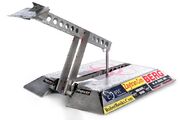
Biohazard, the first machine ever to self-right
The origins of the self-righting mechanism lie not only in UK Robot Wars, but in the original US competition, and famous robots Biohazard and Vlad the Impaler.
- In 1996, Biohazard defeated rival machine Vlad the Impaler by pinning it against the wall for 30 seconds. The match ended and Biohazard released its foe, but Vlad, apparently disappointed at the loss, turned and used its pneumatic lifter on Biohazard to flip and immobilize it. Biohazard was able to self-right by use of its electric lifting arm. This is generally believed to be the first display of self-righting at a tournament, but it took place after the conclusion of a match and had no bearing on the outcome.
Vlad the Impaler, the first robot to self-right during a battle
- In 1997, in another match between Biohazard and Vlad the Impaler, Vlad demonstrated its special pneumatic device that could quickly and repeatedly pop Vlad back upright from an inverted orientation. The device was successfully used to self-right from an immobilized position several times, but Vlad lost the match in a judge's decision.
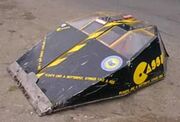
Cassius, father of the srimech, the first robot to self-right and manage to continue in the tournament
- In Robot Wars: The Second Wars, Cassius was flipped onto its back by Sir Killalot during the Pinball trial[1]. Despite this, Cassius used its flipping arm to self-right, landing on its wheels and managing to continue the Pinball trial. This was the first recorded time that a srimech had allowed a robot to continue in a tournament.
- Later in that Series, Cassius was fighting reigning UK Champion Roadblock. Cassius was once again flipped over, but used its righting arm to land back on its wheels and go on to defeat Roadblock in battle. This was the first ever recorded instance of a robot going on to win a battle after being flipped.
The term was coined by Rex Garrod after Cassius self-righted for the first time. All three robots are credited with the evolution of the Self-Righting Mechanism, and are all members of The Combat Robot Hall of Fame.
Types
During the show's history, there were three different ways in which a robot could self-right:
Weapons
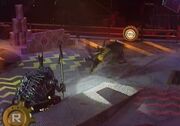
Cassius self-rights for the first time
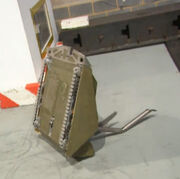
Mortis demonstrates its self-righting arm

Iron-Awe, the first robot to use an overhead weapon to self-right

Ceros is counted out after losing power to its flipper
The first and simplest way was through the use of a robot's own weapon. This was first seen in Series 2, where eventual runners-up Cassius used its flipping arm to right itself after being flipped over on two occasions. Earlier in Series 2, Chaos also attempted to self-right using its own flipping arm, but failed to do so. After Series 2, more robots began to be capable of righting themselves using their flippers, starting with Chaos 2 in its Series 3 Heat Final, with other flipper-wielding robots, including Firestorm, Bigger Brother, Thermidor 2 and Apollo, all proving capable of doing so in later series.
In Series 4, Iron-Awe became the first robot to self-right using an axe, and this was followed by others including Dominator 2, Terrorhurtz and Thor as the series progressed. Other forms of self-righting weapons included the lifting arms of Wild Thing and Mortis, and the lifting scoop of Behemoth, which was upgraded to do so for the 2016 series.
The advantage of self-righting through use of a weapon is that focus can be put on the weapon itself without having to make room or weight allowances for a secondary mechanism to right the robot. The main disadvantage, however, is that they could be rendered ineffective if the weapon was damaged or disabled. In the case of pneumatic weapons including flippers and axes, they could lose effectiveness over time with every usage due to their limited CO2 supplies, and eventually be unable to self-right when it ran out. This ultimately cost robots like Chaos 2, Tsunami and TR2 throughout both the original and 2016 series.
| Srimech Type | Description of srimech | Notable robots |
|---|---|---|
| Rear-hinged true flipper | Robots are catapulted in an arch back onto their wheels. One of the most entertaining to watch but the one where CO2 depletion is most problematic. Chaos 2 was the first to self-right successfully using this weapon type. | Chaos 2, Thermidor 2, Apollo |
| Front-hinged true flipper | Flipper activates and pushes body up and backwards until gravity pulls it back onto its wheels. Does not require an "explosive" flip but fails if pinned or does not have a clear space behind it. | Firestorm 2-5, G.B.H. 2, Mute |
| Rear-hinged flipping arm | Robots are catapulted in an arch back onto their wheels. Easier to use on an angle (when side-stranded), but also suffers from the same CO2 problem as true flippers. | Gemini, Sir Chromalot (Series 5 and 6) |
| Front-hinged flipping arm | Same motion and strengths/weaknesses as the front-hinged true flipper. The first type of srimech to work successfully on the show (Cassius, Series 2 Semi-Final). | Cassius, Fire Storm |
| Lifters | The robot is heaved onto its wheels as the lifter opens. Lacks the powerful trajectory that rear-hinged flippers have. | Wild Thing (Series 4-5), Mortis |
| Lifting scoops | Same motion as Lifters. Effectiveness depends on the weapon's design, size and power. | Behemoth (2016 Series) |
| Spiked axes/Bladed axes/Hammers | Functions essentially in the same method as front-hinged flipping arms. Suffer from balancing issues if the robot is too wide or heavy (as seen in Bamm Bamm's failure in Series 7), and from limited CO2 supplies if pneumatically-powered. | Dominator 2, Iron-Awe, Terrorhurtz |
| Vertical crushers | An example of this never appeared in a televised battle on Robot Wars, but a single competitor, TX-108, which competed in an unaired battle of Robot Wars Extreme, used a crushing arm that could push backwards as a srimech. This allowed the robot to save weight, at the expense of slow self-righting. | TX-108 |
| Rotating Ring | A large, rotating, metal ring around the robot that can tip it back on its wheels as well as flipping/lifting other robots. | Nuts |
Separate Mechanisms
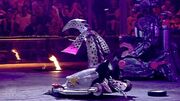
Razer raises its wings
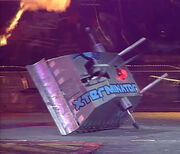
The Series 4 X-Terminator's side spikes push it back onto its wheels
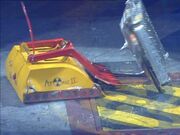
Hypno-Disc heaves itself back upright against Atomic 2
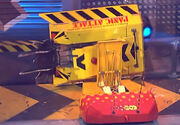
Panic Attack struggles to self-right against Firestorm 3
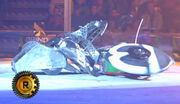
Razer has one of its wings ripped off by 13 Black
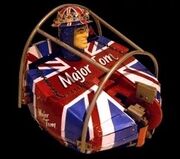
The Series 6 version of Major Tom, showing the rollcage
Not every weapon type had a self-righting capability, so the second form of srimech was a separate mechanism added to the robot, which existed in various forms across the show's history. These included top-mounted lids such as those found on the later incarnations of Panic Attack, to the side-mounted bars of Hypno-Disc and Ironside3, and, perhaps most famously, the self-righting wings attached to Razer's crushing beak. They could either function by re-righting the robot when it was on its back, or from its sides where it was most susceptible to being stranded, as with Razer's wings and the side spikes and side arms used by various incarnations of X-Terminator.
These self-righting mechanisms had the advantage that they did not detract from the efficiency and longevity of a robot's weapon, but at the same time they could often be easily targeted by opponents, and like weapon-based srimechs were prone to failure if they were damaged or did not work properly. Additionally, they were generally less effective than weapon-based srimechs. This was of particular relevance to Panic Attack, whose self-righting lid rarely succeeded in fully righting the robot, and broke after Refbot tried to free it from the arena wall in the Extreme 2 Commonwealth Carnage. 13 Black's side-bar srimech was also susceptible to failing, which it did in both of its Series 7 battles, while Razer's wings were easily torn off by both Big Nipper and 13 Black during its appearances.
| Srimech Type | Description of srimech | Notable robots |
|---|---|---|
| Side-Bars | A small, top-mounted bar mechanism intended to push the robot sideways back onto its wheels. Rare, with Hypno-Disc being the first robot to use one, although it was not seen in action until Extreme 1. | Hypno-Disc, 13 Black, Ironside3 |
| Overhead Bar | The Alien featured a variation of the bar-srimech that functioned overhead, turning the robot over its front. Notably, however, it malfunctioned in Series 5 after getting stuck on its own spinning hammer. | The Alien |
| Rear "Lid" | A rear-mounted srimech which ranged from a simple series of bars (like Cedric Slammer) to a full-covered "lid" (like the Series 4-5 versions of Panic Attack). These srimechs were often ineffective and prone to failure, with Panic Attack only self-righting once in three attempts. | Panic Attack, Cedric Slammer |
| Side Spikes | Pneumatic spikes situated on either side of the robot, which would push it back over if it was positioned on its side. | X-Terminator(Series 3-4, Series 7) |
| Side Arms | A mechanism very similar to the side spikes. Small arm-like mechanisms installed into the side of the robot which would push it back onto its wheels, and were attached close to the robot's base. | ICU, X-Terminator(Series 5-6), Eric |
| Tower Mechanism | The Series 4 version of Sir Chromalot featured a unique self-righting mechanism which was largely based on the side arm srimech. Supported by a large tower, a series of arms would push down on the robot, much like an umbrella, in an attempt to push it back onto its wheels. This srimech was never properly seen in action. | Sir Chromalot (Series 4) |
| Rollcage | A series of bars mounted on top of the robot to help it roll back over if it was flipped. The main difference between rollcages and the "rollover" design used by other robots is that the bars are exposed and separate from the robot, often leaving them vulnerable to being damaged in the process. | Spikasaurus, Major Tom (Series 6) |
| Wings | First, and most notably, used by Razer, these were most commonly seen in robots armed with vertical crushers. These were usually two blade- or wing-shaped mechanisms mounted either side of the robot, which were attached to the crusher by a cable, and would open when the crusher reached a certain angle. | Razer, Ming 3, Chompalot |
Body Shape

The rollover design of Mini Morg
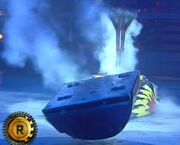
Mega Morg lies stranded after the flip by Robochicken
The third, and rarer, form of self-righting came from the robot's body. Some robots, such as Velocirippa and the Morgue series of robots, were designed as such that they would be able to roll back onto their wheels when they were flipped. Usually, these robots were semi-cylindrically shaped, and the srimech functioned similarly to the rollcage. The first robot to boast a roll-over body was Series 2 competitor, Ivanhoe, with the most notable and successful examples being the Morgue series.
Although extremely effective and reliable if designed correctly, requiring no power from a seperate weapon or mechanism, the body-shape srimech was difficult to design properly, and it was possible for the robot to become stranded on its back if the flip lacked momentum. These shortcomings resulted in Ivanhoe's defeat in Series 2 as it was lifted onto its side by G.B.H., and Mega Morg's loss in Series 7 after it was flipped straight onto its back by Robochicken.
References
| ||||||||||||||||||||||||||||||||
